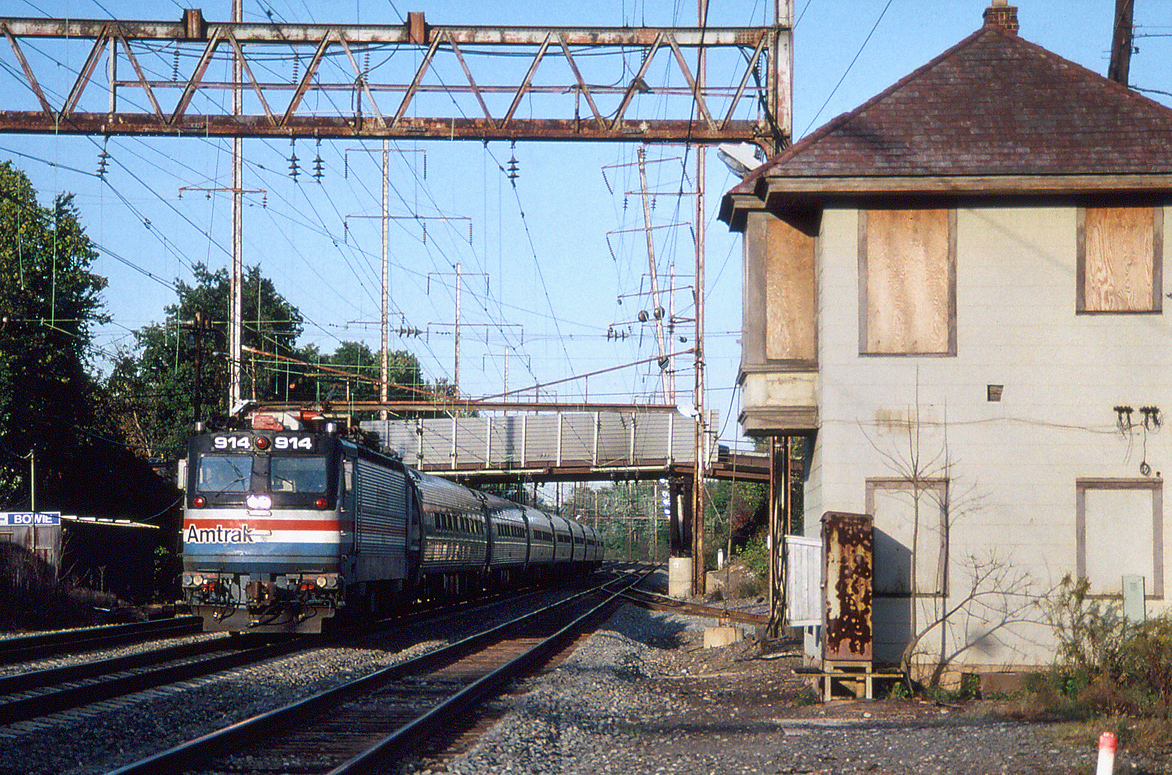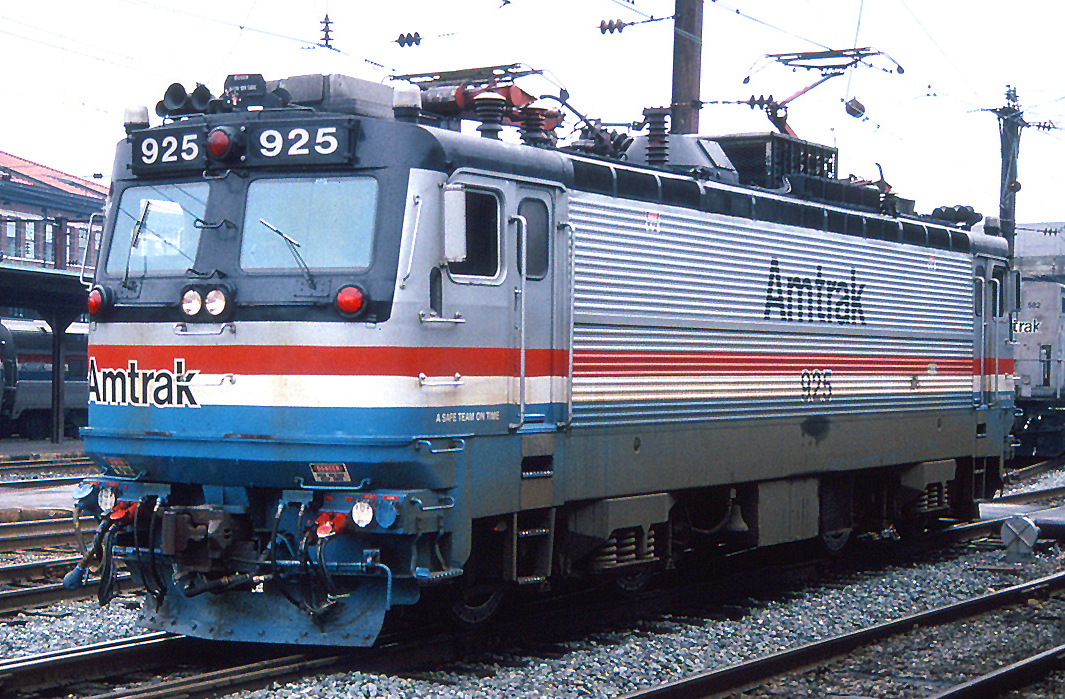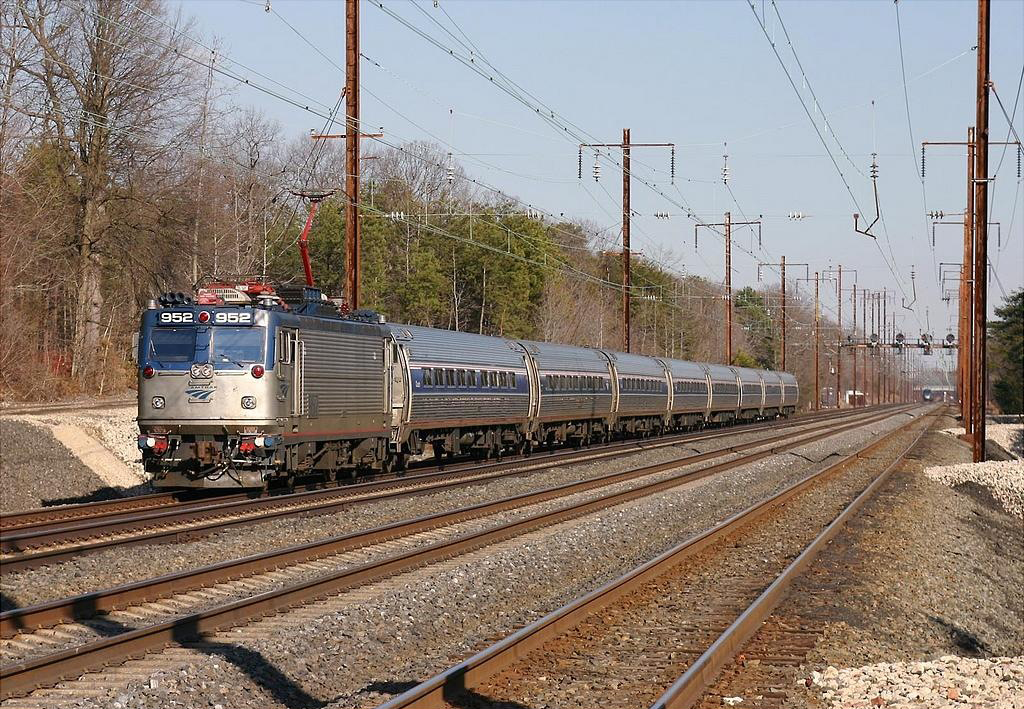Amtrak "AEM-7" Locomotives: Roster, Specs, Survivors
Last revised: February 26, 2025
By: Adam Burns
The AEM-7 electric locomotive resulted from a test the passenger carrier did on French and Swedish models. After several tests Amtrak was pleased with the Swedish Rc4 and would
eventually settle on it as a basis for what would become its AEM-7.
The new electric locomotive model was built by General Motors' Electro-Motive Division (EMD) in the late 1970s through the 1980s and allowed Amtrak to retire the rest of its GG1 fleet and unsuccessful E60s, which were originally meant to place its aging fleet of electrics in the mid-1970s.
In 2010 Amtrak ordered 70 ACS-64 locomotives from Siemens to replace its aging fleet of AEM-7's. The carrier held a special "Farewell To The AEM-7" excursion on June 18, 2016 marking the end of their service following nearly four decades of continuous service.
In addition, operators MARC Train and Southeastern Pennsylvania Transportation Authority (SEPTA) retired their respective units during 2017 and 2018.
While none of Amtrak's AEM-7's remain in service, #929 and #938 were acquired by Caltrain in 2019; #928 and #942 were moved to the Transportation Technology Center, Inc. in 2017; and two are officially preserved, #915 at the Railroad Museum of Pennsylvania and #945 at the Illinois Railway Museum.
 Amtrak AEM-7 #914 hustles past the closed tower at Bowie, Maryland with a southbound on October 8, 1991. Wade Massie photo.
Amtrak AEM-7 #914 hustles past the closed tower at Bowie, Maryland with a southbound on October 8, 1991. Wade Massie photo.History
In the late 1970s Amtrak was looking for a new high-speed electric locomotive to not only replace the rest of its outdated GG1s but also retire its E60s, a General Electric product.
These locomotives, like EMD's SDP40F's, turned out to be a big disappointment (a poor design of its trucks and extremely heavy weight for a passenger locomotive precluded it from operating at speeds over 90 mph).
This setback was somewhat surprising considering that through the years GE had been known as a quite competent designer and builder of electric locomotives.
So, after being pleased with tests done on a Swedish Rc4, the most successful electric locomotive design at the time, Amtrak contracted with EMD to build a fleet of 54 passenger electrics dubbed AEM-7s.
These motors used the latest in electric locomotive technology featuring thyristor motor control and traction motors that provided maximum power without wheel slip.
The Amtrak’s AEM-7 was noticeably more powerful and heavily built than the Swedish models, partly due to design mandates by the Federal Railroad Administration.
The AEM-7 could easily cruise over 100 mph on the NEC and could deliver a whopping 7,000 hp with over 53,000 pounds of tractive effort.
Today, the AEM-7 fleet continues to provide daily commuter service duties for Amtrak, along with the South Eastern Pennsylvania Transportation Authority (SEPTA) and Maryland Rail Commuter (MARC) which also both own a small fleet of the motors.
In one of the few instances in recent memory in which an EMD product was constructed far superior to a GE design, the AEM-7 was simply a much better design and more efficient locomotive than the E60 and its variants.
Where the E60 featured a C-C truck setup (three axles per truck) the AEM-7 used a smaller B-B design (two axles per truck).
This not only allowed the EMD model to be much smaller at just 51 feet in length (as opposed to the E60's 70 feet) but also much lighter at just 101 tons. In contrast, the GE's model weighed nearly twice that amount, 193.5 tons.
The lighter weight allowed the AEM-7 to be much more stable on the rails and operate at higher speeds of 125 mph.
Amtrak began placing orders for the AEM-7 in 1978, before it had even completed its order of E60CPs and E60PHs.
All of the model's internal components were designed and built by Allmänna Svenska Elektriska Aktiebolaget (ASEA) of Sweden.
However, the locomotive's stainless-steel, ribbed carbody may look familiar to some as it was designed by the legendary Budd Company, which by the late 1970s was still serving a limited market for passenger equipment.
"AEM-7" Locomotive Roster
| Owner | Fleet | Builders | Dates Built | Disposition |
|---|---|---|---|---|
| Amtrak | 900-953 | EMD/ASEA | 1980-1988 | Retired 2016* |
| MARC | 4900-4903 | EMD/ASEA | 1986 | Retired 2017 |
| SEPTA | 2301-2307 | EMD/ASEA | 1987 | Retired 2018 |
* Based off the Rc4 design, 29 of the AEM-7's were rebuilt by Alstom between 1999-2002. #915 and #945 are officially preserved; the former at the Railroad Museum of Pennsylvania and the latter at the Illinois Railway Museum.
AEM-7 Specifications
| Current | Horsepower (Continuous) | Current | Length | Truck Centers |
|---|---|---|---|---|
| AC | 7000 | 12.5/25kv, 25/60hz | 51' 1.8" | 25' 7.1" |
 Amtrak AEM-7 #925 awaits its next assignment at Washington Union Station on March 22, 1991. Wade Massie photo.
Amtrak AEM-7 #925 awaits its next assignment at Washington Union Station on March 22, 1991. Wade Massie photo.Amtrak's first batch of AEM-7s, 46 units, began service between 1980 and 1982 after it had received its first a year earlier in 1979.
By 1988 the carrier's order for the model was complete, at 54 units, more than double the total number it had purchased of GE's E60 design.
Altogether, EMD would construct 65 AEM-7s as both the Southeastern Pennsylvania Transportation Authority (SEPTA) and Maryland's MARC commuter service purchased a few examples of the model.
Recent Articles
-
Michigan Dinner Train Rides In Owosso!
Jan 15, 26 09:46 AM
The Steam Railroading Institute is best known as the home of Pere Marquette #1225 and even occasionally hosts a dinner train! -
Arizona's - Wine Tasting - Train Rides
Jan 14, 26 02:04 PM
For those who want to experience the charm of Arizona's wine scene while embracing the romance of rail travel, wine tasting train rides offer a memorable journey through the state's picturesque landsc… -
Arkansas's - Wine Tasting - Train Rides
Jan 14, 26 01:57 PM
This article takes you through the experience of wine tasting train rides in Arkansas, highlighting their offerings, routes, and the delightful blend of history, scenery, and flavor that makes them so… -
Tennessee ~ Murder Mystery ~ Dinner Train Rides
Jan 14, 26 01:42 PM
Amidst the rolling hills and scenic landscapes of Tennessee, an exhilarating and interactive experience awaits those with a taste for mystery and intrigue. -
California ~ Murder Mystery ~ Dinner Train Rides
Jan 14, 26 01:26 PM
When it comes to experiencing the allure of crime-solving sprinkled with delicious dining, California's murder mystery dinner train rides have carved a niche for themselves among both locals and touri… -
Illinois ~ Murder Mystery ~ Dinner Train Rides
Jan 14, 26 01:13 PM
Among Illinois's scenic train rides, one of the most unique and captivating experiences is the murder mystery excursion. -
Vermont's - Murder Mystery - Dinner Train Rides
Jan 14, 26 12:57 PM
There are currently murder mystery dinner trains offered in Vermont but until recently the Champlain Valley Dinner Train offered such a trip! -
Massachusetts Dinner Train Rides On Cape Cod!
Jan 14, 26 12:20 PM
The Cape Cod Central Railroad (CCCR) has carved out a special niche by pairing classic New England scenery with old-school hospitality, including some of the best-known dining train experiences in the… -
Maine Dinner Train Rides In Portland!
Jan 14, 26 11:31 AM
While this isn’t generally a “dinner train” railroad in the traditional sense—no multi-course meal served en route—Maine Narrow Gauge does offer several popular ride experiences where food and drink a… -
Kentucky Dinner Train Rides In Bardstown!
Jan 13, 26 01:14 PM
The essence of My Old Kentucky Dinner Train is part restaurant, part scenic excursion, and part living piece of Kentucky rail history. -
Kansas Dinner Train Rides In Abilene!
Jan 13, 26 12:44 PM
If you’re looking for a heritage railroad that feels authentically Kansas—equal parts prairie scenery, small-town history, and hands-on railroading—the Abilene & Smoky Valley Railroad (A&SV) delivers. -
Michigan ~ Murder Mystery ~ Dinner Train Rides
Jan 13, 26 11:24 AM
Among the lesser-known treasures of this state are the intriguing murder mystery dinner train rides—a perfect blend of suspense, dining, and scenic exploration. -
Virginia's - Murder Mystery - Dinner Train Rides
Jan 13, 26 11:11 AM
Among the state's railroad attractions, murder mystery dinner trains stand out as a captivating fusion of theatrical entertainment, fine dining, and scenic travel. -
Arizona Dinner Train Rides At The Grand Canyon!
Jan 13, 26 10:59 AM
While the Grand Canyon Railway does not offer a true, onboard dinner train experience it does offer several upscale options and off-train dining. -
Georgia Dinner Train Rides In Nashville!
Jan 13, 26 10:27 AM
If you’ve ever wished you could slow down, trade traffic for jointed rail, and let a small-town landscape roll by your window while a hot meal is served at your table, the Azalea Sprinter delivers tha… -
Indiana Valentine's Train Rides
Jan 12, 26 04:27 PM
If you’ve ever wished you could step into a time when passenger trains were a Saturday-night treat and a whistle echoing across farm fields meant “adventure,” the Nickel Plate Express delivers that fe… -
Ohio Valentine's Train Rides!
Jan 12, 26 04:20 PM
The Hocking Valley Scenic Railway offers one of the region’s most atmospheric ways to experience the Hocking Hills area: from the rhythmic click of jointed rail to the glow of vintage coaches rolling… -
Wisconsin's - Wine Tasting - Train Rides
Jan 12, 26 03:10 PM
Wisconsin might not be the first state that comes to mind when one thinks of wine, but this scenic region is increasingly gaining recognition for its unique offerings in viticulture. -
California's - Wine Tasting - Train Rides
Jan 12, 26 02:34 PM
This article explores the charm, routes, and offerings of these unique wine tasting trains that traverse California’s picturesque landscapes. -
Wisconsin Scenic Train Rides In North Freedom!
Jan 12, 26 02:20 PM
The Mid-Continent Railway Museum is a living-history museum built around the sights, sounds, and everyday rhythms of small-town and shortline railroading in the early 20th century, what the museum cal… -
Vermont Scenic Train Rides In Burlington!
Jan 12, 26 01:18 PM
Today, GMRC is best known by many travelers for its Burlington-based passenger experiences—most famously the Champlain Valley Dinner Train and the sleek, limited-capacity Cocktails on the Rails. -
Maryland's - Murder Mystery - Dinner Train Rides
Jan 12, 26 01:03 PM
Maryland is known for its scenic landscapes, historical landmarks, and vibrant culture, but did you know that it’s also home to some of the most thrilling murder mystery dinner trains? -
Minnesota's - Murder Mystery - Dinner Train Rides
Jan 12, 26 12:17 PM
Murder mystery dinner trains offer an enticing blend of suspense, culinary delight, and perpetual motion, where passengers become both detectives and dining companions on an unforgettable journey. -
Vermont Dinner Train Rides In Burlington!
Jan 12, 26 12:09 PM
There is one location in Vermont hosting a dedicated dinner train experience at the Green Mountain Railroad. -
Connecticut Dinner Train Rides In Essex!
Jan 12, 26 10:39 AM
Connecticut's rail heritage can be traced back to the industry's earliest days and a few organizations preserve this rich history by offering train rides. The Essex Steam Train also hosts dinner-theme… -
Florida Scenic Train Rides In Parrish!
Jan 11, 26 10:26 PM
The Florida Railroad Museum (FRRM) in Parrish offers something increasingly rare in today’s rail landscape: a chance to ride historic equipment over a surviving fragment of an early-20th-century mainl… -
California's - Wine Tasting - Train Rides
Jan 11, 26 02:28 PM
This article explores the charm, routes, and offerings of these unique wine tasting trains that traverse California’s picturesque landscapes. -
Georgia's - Murder Mystery - Dinner Train Rides
Jan 11, 26 02:07 PM
In the heart of the Peach State, a unique form of entertainment combines the thrill of a murder mystery with the charm of a historic train ride. -
Colorado ~ Murder Mystery ~ Dinner Train Rides
Jan 11, 26 01:43 PM
Nestled among the breathtaking vistas and rugged terrains of Colorado lies a unique fusion of theater, gastronomy, and travel—a murder mystery dinner train ride. -
Minnesota Dinner Train Rides In Duluth!
Jan 11, 26 01:32 PM
One of the best ways to feel the region's history in motion today is aboard the North Shore Scenic Railroad (NSSR), which operates out of Duluth’s historic depot. -
Illinois Dinner Train Rides At Monticello!
Jan 11, 26 12:42 PM
The Monticello Railway Museum (MRM) is one of those places that quietly does a lot: it preserves a sizable collection, maintains its own operating railroad, and—most importantly for visitors—puts hist… -
Alabama's - Wine Tasting - Train Rides
Jan 10, 26 09:29 AM
While the state might not be the first to come to mind when one thinks of wine or train travel, the unique concept of wine tasting trains adds a refreshing twist to the Alabama tourism scene. -
Maryland Dinner Train Rides At WMSR!
Jan 10, 26 09:13 AM
The Western Maryland Scenic Railroad (WMSR) has become one of the Mid-Atlantic’s signature heritage operations—equal parts mountain railroad, living museum, and “special-occasion” night out. -
Arkansas Dinner Train Rides On The A&M!
Jan 10, 26 09:11 AM
If you want a railroad experience that feels equal parts “working short line” and “time machine,” the Arkansas & Missouri Railroad (A&M) delivers in a way few modern operations can. -
South Dakota's - Murder Mystery - Dinner Train Rides
Jan 10, 26 09:08 AM
While the state currently does not offer any murder mystery dinner train rides, the popular "1880 Train" at the Black Hills Central recently hosted these popular trips! -
Wisconsin's - Murder Mystery - Dinner Train Rides
Jan 10, 26 09:07 AM
Whether you're a fan of mystery novels or simply relish a night of theatrical entertainment, Wisconsin's murder mystery dinner trains promise an unforgettable adventure. -
Missouri's - Murder Mystery - Dinner Train Rides
Jan 10, 26 09:05 AM
Missouri, with its rich history and scenic landscapes, is home to one location hosting these unique excursion experiences. -
Washington ~ Murder Mystery ~ Dinner Train Rides
Jan 10, 26 09:04 AM
This article delves into what makes murder mystery dinner train rides in Washington State such a captivating experience. -
Kentucky Scenic Train Rides At KRM!
Jan 09, 26 11:13 PM
Located in the small town of New Haven the Kentucky Railway Museum offers a combination of historic equipment and popular excursions. -
Washington "Wine Tasting" Train Rides
Jan 09, 26 08:53 PM
Here’s a detailed look at where and how to ride, what to expect, and practical tips to make the most of wine tasting by rail in Washington. -
Kentucky's - Wine Tasting - Train Rides
Jan 09, 26 08:21 PM
Kentucky, often celebrated for its rolling pastures, thoroughbred horses, and bourbon legacy, has been cultivating another gem in its storied landscapes; enjoying wine by rail. -
Kentucky's - Murder Mystery - Dinner Train Rides
Jan 09, 26 01:12 PM
In the realm of unique travel experiences, Kentucky offers an enchanting twist that entices both locals and tourists alike: murder mystery dinner train rides. -
Utah's - Murder Mystery - Dinner Train Rides
Jan 09, 26 01:05 PM
This article highlights the murder mystery dinner trains currently avaliable in the state of Utah! -
North Carolina Dinner Train Rides At NCTM!
Jan 09, 26 12:51 PM
Tucked into the Piedmont town of Spencer, the North Carolina Transportation Museum is the kind of place that feels less like a typical museum and more like a living rail yard that never quite stopped… -
Tennessee Dinner Train Rides At The TVRM!
Jan 09, 26 12:39 PM
Tucked into East Chattanooga, the Tennessee Valley Railroad Museum (TVRM) is less a “museum you walk through” and more a railroad you step aboard. -
New York Scenic Train Rides On The A&A!
Jan 09, 26 11:20 AM
The A&A is both a common-carrier short line moving freight and a heritage railroad hosting popular excursion trains, all on the same storied right-of-way. -
Pennsylvania Scenic Train Rides In Hollidaysburg!
Jan 09, 26 11:14 AM
Tucked into the Juniata River valley just south of Altoona, the Everett Railroad offers one of the most approachable—and photogenic—heritage-rail experiences in Pennsylvania -
Montana Dinner Train Rides Near Lewistown!
Jan 08, 26 03:03 PM
The Charlie Russell Chew Choo turns an ordinary rail trip into an evening event: scenery, storytelling, live entertainment, and a hearty dinner served as the train rumbles across trestles and into a t… -
Alabama's - Murder Mystery - Dinner Train Rides
Jan 08, 26 02:19 PM
There is currently one location in the state offering a murder mystery dinner experience, the Wales West Light Railway! -
Rhode Island's - Murder Mystery - Dinner Train Rides
Jan 08, 26 01:43 PM
Let's dive into the enigmatic world of murder mystery dinner train rides in Rhode Island, where each journey promises excitement, laughter, and a challenge for your inner detective.

















































